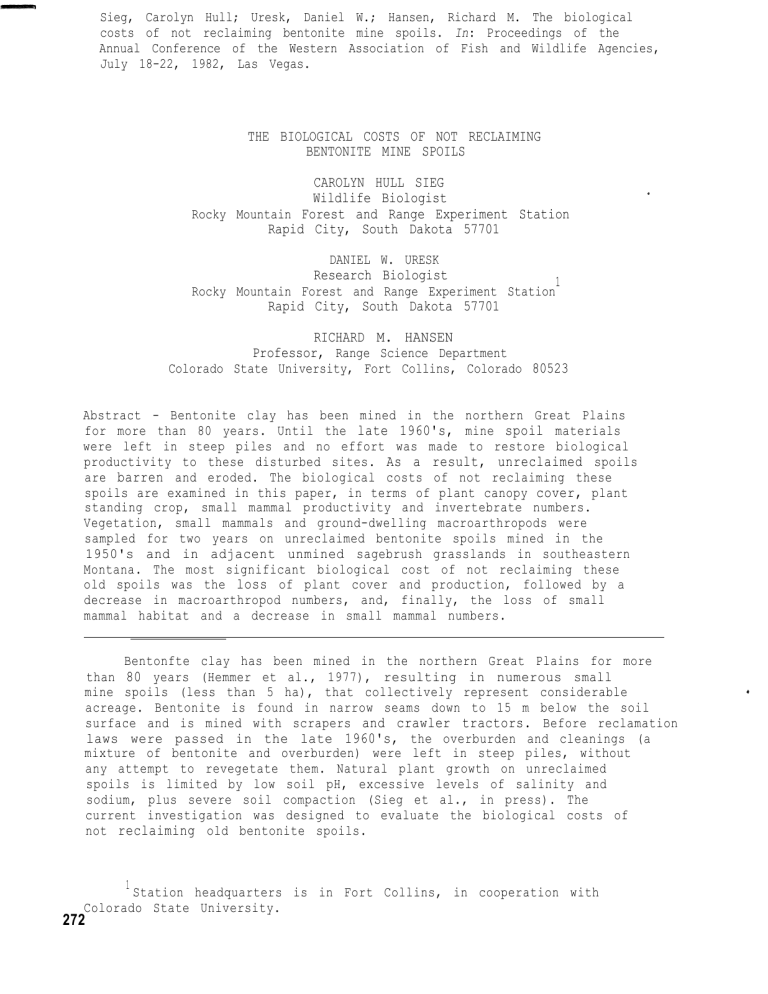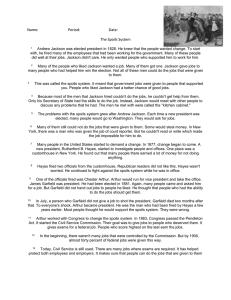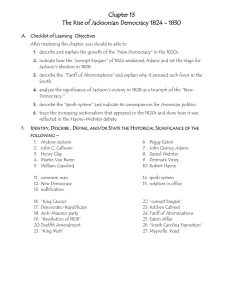Sieg, Carolyn Hull; Uresk, Daniel W.; Hansen, Richard M. The... In Annual Conference of the Western Association of Fish and Wildlife...

Sieg, Carolyn Hull; Uresk, Daniel W.; Hansen, Richard M. The biological costs of not reclaiming bentonite mine spoils. In : Proceedings of the
Annual Conference of the Western Association of Fish and Wildlife Agencies,
July 18-22, 1982, Las Vegas.
THE BIOLOGICAL COSTS OF NOT RECLAIMING
BENTONITE MINE SPOILS
CAROLYN HULL SIEG
Wildlife Biologist
Rocky Mountain Forest and Range Experiment Station
Rapid City, South Dakota 57701
DANIEL W. URESK
Research Biologist
Rocky Mountain Forest and Range Experiment Station
1
Rapid City, South Dakota 57701
RICHARD M. HANSEN
Professor, Range Science Department
Colorado State University, Fort Collins, Colorado 80523
Abstract - Bentonite clay has been mined in the northern Great Plains for more than 80 years. Until the late 1960's, mine spoil materials were left in steep piles and no effort was made to restore biological productivity to these disturbed sites. As a result, unreclaimed spoils are barren and eroded. The biological costs of not reclaiming these spoils are examined in this paper, in terms of plant canopy cover, plant standing crop, small mammal productivity and invertebrate numbers.
Vegetation, small mammals and ground-dwelling macroarthropods were sampled for two years on unreclaimed bentonite spoils mined in the
1950's and in adjacent unmined sagebrush grasslands in southeastern
Montana. The most significant biological cost of not reclaiming these old spoils was the loss of plant cover and production, followed by a decrease in macroarthropod numbers, and, finally, the loss of small mammal habitat and a decrease in small mammal numbers.
Bentonfte clay has been mined in the northern Great Plains for more than 80 years (Hemmer et al., 1977), resulting in numerous small mine spoils (less than 5 ha), that collectively represent considerable acreage. Bentonite is found in narrow seams down to 15 m below the soil surface and is mined with scrapers and crawler tractors. Before reclamation laws were passed in the late 1960's, the overburden and cleanings (a mixture of bentonite and overburden) were left in steep piles, without any attempt to revegetate them. Natural plant growth on unreclaimed spoils is limited by low soil pH, excessive levels of salinity and sodium, plus severe soil compaction (Sieg et al., in press). The current investigation was designed to evaluate the biological costs of not reclaiming old bentonite spoils.
1
Station headquarters is in Fort Collins, in cooperation with
272
Colorado State University.
Study Area and Methods
This study was conducted in Carter County, Montana, approximately 9 km west of Alzada. The study area was located on a dense clay-clayey-saline upland range site complex (Ross and Hunter, 1976), in a sagebrush-saltbush/ southeastern grassland vegetative type (Payne, 1973). Elevations ranged from 1000 - 1100 m. Major shrubs were big sagebrush (Artemisia tridentata) and plains prickly pear (Opuntia polyacantha). Prevalent grasses included western wheatgrass (Agropyron smithii), buffalograss (Buchloe dactyloides), and blue grama Scarlet globemallow (Sphaeralcea scoccinea) was the most common forb. The sparse vegetation of unreclaimed mine spoils was dominated by scurfless saltbush (Atriplex suckleyi).
Average annual precipitation for the area is 37 cm. Snowfalls are frequent from November through April. The mean temperature is 7.8° C, ranging from -6.4° in January to 22.6° C in July.
Plant canopy cover, plant standing crop, macroarthropods, and small mammals were sampled on old spoils and in adjacent sagebrush grasslands in 1979 and 1980 to assess the biological costs of not reclaiming bentonite mine spoils. Seven 60- x 60-m (0.36-ha) study sites were selected: five on old mine spoils (12 - 28 years old) constructed before reclamation laws were passed, and two on gently undulating unmined big sagebrush-grass rangeland. All sites were grazed by sheep and cattle.
Plant canopy cover was estimated on the seven sites during late spring, midsummer and late summer of 1979 and 1980. Plant canopy cover was estimated using methods modified from Daubenmire (1959), in 150 quadrats (20 x 50 cm) placed at l-m intervals along three permanent
50-m line transects on each site. Canopy cover was estimated visually to fall into one of seven cover classes: 0 = less than 1% cover; 1 =
1 - 5%; 2 = 5 - 25%; 3 = 25 - 50%; 4 = 50 - 75%; 5 = 75 - 95%; and 6 =
95 - 100% cover. Plants were identified according to Nickerson et al.
(1976).
Plant standing crop was estimated on all sites annually by harvesting all plants except big sagebrush at ground level at estimated peak production
(late July) on all sites. Plants were clipped in ten 20- x 50-cm quadrats on each of three permanent transects on each site. Plant species were separated in the field, oven-dried in the laboratory at 60° C for 48 hours, and weighed.
Ground-dwelling macroarthropod populations were sampled with pitfall traps made of 15- x 15-cm metal cans. Twelve cans were buried flush with the soil surface in a grid pattern with 15-m spacing. The traps were opened every three weeks from April through October of each year for three consecutive nights. The invertebrates were collected, classified and counted daily.
.
Relative abundance of small mammals was estimated for each site with 36 Sherman live traps (23 x 9 x 9 cm) arranged in a grid design with 10-a spacing. Trapping began in April of each year and continued at three week intervals until October. Each trapping session consisted of one night of prebaiting followed by three consecutive nights of trapping. Rolled oats mixed with peanut butter was placed in the live traps to attract small mammals.
Upon removal from traps, mammals were identified as to species, sex, age, and reproductive status, and were assigned a unique four-digit number by toe amputation, as described by Taber and Cowan (1971). Hall
(1981) was used as the authority for common and scientific names of mammals.
Three times during each year, in late spring, midsummer, and late summer, study sites were inspected for small mammal burrows. The number of burrows found along permanent line transects, 50 m in length and 1 m wide, was recorded for each study site.
' Results
The most significant biological cost of not reclaiming bentonite mine spoils was the loss of plant canopy cover and standing crop. Total plant canopy cover on the unreclaimed bentonite mine spoils averaged 29% less than on the unmined sagebrush-grasslands (Fig. la), 25 fewer plant species were present on the spoils, and the plant standing crop deficit on the unreclaimed spoils was 372 kg/ha (Fig, lb). A bentonite spoil left unreclaimed for 30 years would result in an estimated accumulated loss of 11,160 kg/ha in plant standing crop. The actual loss would be even higher when the standing crop of big sagebrush and forage consumed by livestock are accounted for.
Loss of total numbers of ground-dwelling macroarthropods comprised another biological cost of not reclaiming bentonite mine spoils.
Macroarthropod numbers averaged 163 less per hectare than on the unmined sagebrush-grasslands (Fig, 1c). The accumulated loss on a 30-year-old unreclaimed spoil would be 4,890 macroarthropods per hectare.
Not reclaiming bentonite mine spoils also resulted in the loss of small mammal numbers and habitat. An average of 19 fewer animals per hectare were captured on the unreclaimed mine spoils, compared to the rangelands (Fig, 1d). At an annual loss of 19 animals per hectare, a bentonite spoil left unreclaimed for 30 years would result in a deficit of 570 animals per hectare.
The loss of small mammal burrowing habitat was an added cost of not reclaiming bentonite spoils. Small mammal burrows were limited to sagebrush-grass rangelands. An average of 50 burrows per ha were found on the sagebrush-grass sites, whereas small mammal burrows were not detected on the unreclaimed mine spoil habitats. Burrowing habitat would be eliminated on unreclaimed spoils, at a loss of 50 burrows per hectare.
274
Discussion
The total biological cost of not reclaiming bentonite mine spoils is the deterioration of sagebrush-grasslands into spoils habitats that support fewer plants, macroarthropods, and animals. The annual costs appear insignificant in some cases, but when summed over 30 years, become very significant. Compacted soils, low in organic matter, support few plants and, based on the absence of burrows and high penetrometer readings (Sieg et al., in press), are inpenetrable for small mammal burrowing. Plant cover and standing crop deficits reduce the wildlife and livestock carrying capacity of the range. Lower macroarthropod and small mammal numbers potentially limit mammal and bird populations at higher trophic levels.
Because bentonite spoils are small, the low biological productivity on unreclaimed areas is compensated to some degree by surrounding unmined sagebrush-grasslands. However, in areas where unreclaimed spoils are numerous, rangeland productivity is severely reduced and unmined sagebrushgrasslands do not compensate for the resulting biological deficits.
Reclamation efforts may reduce the biological costs of bentonite mining, but several authors have indicated that reclamation techniques used in the past have not been successful (Sieg et al., in press;
Bjugstad, 1979; Bjugstad et al., 1981). Research is needed to identify methods that compensate for adverse physical and chemical properties of the bentonite spoils materials and sparse topsoil. Use of salt-tolerant plant species, such as fourwing saltbush (Atriplex canescens), along with soil fertilization, mulching, and physical amendments have shown some promise in increasing the effectiveness of reclamation efforts
(Bjugstad et al., 1981). However, further information is needed to correctly assess and compensate for the biological costs of bentonite mining in the northern Great Plains.
Acknowledgements
The authors extend appreciation to Lynn Alexander, Colorado State
University, for her help with field work. They also thank the owners of the Wyotana Ranch for their cooperation in this study, and N. L. Baroid,
Inc., and International Minerals Corporation for permission to use their land.
276
Literature Cited
Bjugstad, A. J. 1979. Bentonite mine spoil and pit reclamation: A major research problem. Proc. Mineral Waste Stabilization
Committee, June 21, 1979, Eveleth, Minn. p. 1-19.
Bjugstad, A. J., T. Yamamoto, and D. Uresk. 1981. Shrub establishment on coal and bentonite clay mine spoils. Proc. Shrub Establishment on Disturbed Arid and Semi-Arid Lands Symp., Dec. 2-3, 1980,
Laramie, Wyo. p. 104-122.
Daubenmire, R. 1959. A canopy-coverage method of vegetation analysis.
Northwest Sci. 33:43-64.
Hall, E. R. 1981, The mammals of North America. John Wiley & Sons,
New York, N.Y. 1181 p.
Hemmer, D., S. Johnson, and R. Beck. 1977. Bentonite mining related reclamation problems in the northwestern states. Old West Regional
Comm. Billings, Mont. 94 p.
Nickerson, M. F., G. E. Brink, and C. Feddema. 1976. Principal range plants of the central and southern Rocky Mountains. Names and Symbols.
U.S. Dep. Agr. Forest Serv. Gen. Tech., Rep. RM-20. Rocky Mountain
Forest and Range Exp. Sta., Fort Collins, Colo. 121 p.
Payne, G. F. 1973. Vegetative rangeland types in Montana. Bull. 671.
Montana Agr. Exp. Sta., Bozeman, Mont. 16 p.
Ross, R. L., and H. E. Hunter. 1976. Climax vegetation of Montana.
U.S. Dep. Agr., Soil Conserv. Serv., Bozeman, Mont. 64 p.
Sieg, C. Hull, D. W. Uresk, and R. M. Hansen. In press. Plant-soil relationships on bentonite mine spoils and sagebrush-grasslands in the Northern High Plains. J. Range Manage.
Taber, R. D., and I. McT. Cowan, 1971. Capturing and marking wild animals. p. 277-317. In : R. H. Giles, Jr., Editor. Wildlife
Management Techniques. Third edition. The Wildl. Soc., Washington,
D.C.



